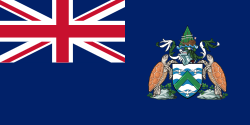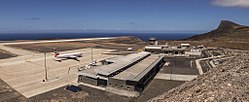
Saint Helena is one of the three constituent parts of Saint Helena, Ascension and Tristan da Cunha, a remote British overseas territory. Saint Helena is a volcanic and tropical island, located in the South Atlantic Ocean, some 1,874 km west of mainland Africa, with Angola and Namibia being the closest nations, geographically. The island is located around 1,950 km (1,210 mi) west of the coast of southwestern South Africa, and 4,000 km (2,500 mi) east of Rio de Janeiro, Brazil. Until 2018, the primary method of reaching Saint Helena was by booking a spot on the RMS St Helena—a cargo and post delivery vessel that also ferried visitors—which routinely made the 3,141 km, six-day journey from Cape Town, South Africa.
Saint Helena, Ascension and Tristan da Cunha are British Overseas Territories in the south Atlantic Ocean.
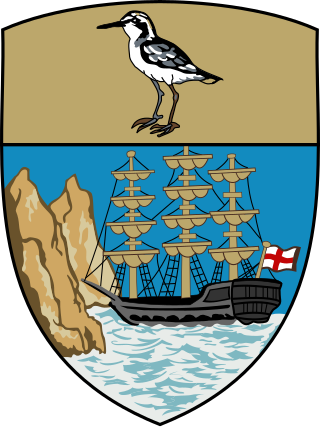
Politics of Saint Helena takes place in a framework of limited self-government as a dependent territory of the United Kingdom, whereby the governor is the head of government. Saint Helena, an island in the southern Atlantic Ocean, is a part of the British overseas territory of Saint Helena, Ascension and Tristan da Cunha.
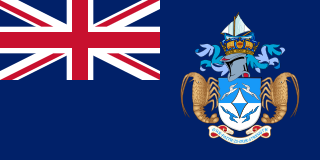
Tristan da Cunha, colloquially Tristan, is a remote group of volcanic islands in the South Atlantic Ocean. It is the most remote inhabited archipelago in the world, lying approximately 2,787 kilometres (1,732 mi) from Cape Town in South Africa, 2,437 kilometres (1,514 mi) from Saint Helena, 3,949 kilometres (2,454 mi) from Mar del Plata in Argentina, South America and 4,002 kilometres (2,487 mi) from the Falkland Islands.
Tristan da Cunha is part of the British overseas territory of Saint Helena, Ascension and Tristan da Cunha and has a history going back to the beginning of the 16th century. It was settled by men from military garrisons and ships, who married native women from Saint Helena and the Cape Colony. Its people are multi-racial, descended from European male founders and mixed-race and African women founders.

The flag of Saint Helena consists of a Blue Ensign defaced with the shield from the British overseas territory's coat of arms. Adopted in 1984 shortly after the island was granted a new coat of arms, it has been the flag since. Saint Helena's flag is similar to the flags of eight other British Overseas Territories, which are also Blue Ensigns with their respective coats of arms.

The Governor of Saint Helena is the representative of the monarch in Saint Helena, a constituent part of the British Overseas Territory of Saint Helena, Ascension and Tristan da Cunha. The governor is appointed by the monarch on the advice of the British government. The current governor of Saint Helena has been Nigel Phillips since 13 August 2022.
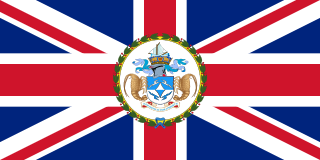
The governor of Tristan de Cunha is the representative of the monarch in Tristan da Cunha, a constituent part of the British Overseas Territory of Saint Helena, Ascension and Tristan da Cunha. The governor is appointed by the monarch on the advice of the British government. The role of the governor is to act as the de facto head of state.

The coat of arms of Saint Helena, part of the British Overseas Territory of Saint Helena, Ascension and Tristan da Cunha, was authorised on 30 January 1984.
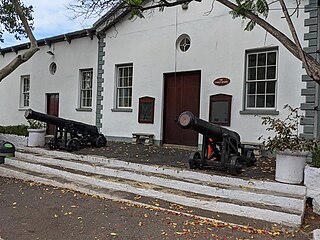
The Supreme Court of St Helena together with the St Helena Court of Appeal are the Senior Courts of the British Overseas Territory of Saint Helena, Ascension and Tristan da Cunha.

The Governor of Ascension is the representative of the monarch in Ascension Island, a constituent part of the British Overseas Territory of Saint Helena, Ascension and Tristan da Cunha. He is appointed by the monarch on the advice of the British government, his role is to act as the de facto head of state.

The following outline is provided as an overview of and topical guide to Ascension Island:

The following outline is provided as an overview of and topical guide to Saint Helena:

The following outline is provided as an overview of and topical guide to Tristan da Cunha:

Ascension Island is an isolated volcanic island, 7°56′ south of the Equator in the South Atlantic Ocean. It is about 1,000 miles (1,600 km) from the coast of Africa and 1,400 miles (2,300 km) from the coast of South America. It is governed as part of the British Overseas Territory of Saint Helena, Ascension and Tristan da Cunha, of which the main island, Saint Helena, is around 800 miles (1,300 km) to the southeast. The territory also includes the sparsely populated Tristan da Cunha archipelago, 2,300 miles (3,700 km) to the south, about halfway to the Antarctic Circle.

Lesbian, gay, bisexual and transgender (LGBT) rights in the British Overseas Territory of Saint Helena, Ascension and Tristan da Cunha have gradually evolved over the years. Discrimination on the basis of sexual orientation is banned in the entire territory through the Constitution Order 2009 and same-sex marriage has been legal on the islands since 2017.
The United Kingdom possesses a number of islands in the South Atlantic Ocean and claims a section of the Antarctic continent. These territories are St. Helena with Ascension Island and Tristan da Cunha, the Falkland Islands, South Georgia and the South Sandwich Islands, and the UK's claimed Antarctic territory, called the British Antarctic Territory. The official currency in these territories is either Pound sterling or a local currency that evolved from sterling and is at a fixed one-to-one parity with sterling.

The politics of Saint Helena, Ascension and Tristan da Cunha operate under the jurisdiction of the government of the United Kingdom. The three parts of the territory—Saint Helena, Ascension Island and Tristan da Cunha—effectively form an asymmetric federacy and collectively constitute one of United Kingdom's fourteen overseas territories.
Same-sex marriage has been legal in Saint Helena, Ascension and Tristan da Cunha since 2017. An ordinance to open marriage to same-sex couples in Saint Helena was passed by the Legislative Council in a 9–2 vote on 19 December 2017. It went into force the following day, and the first same-sex marriage was performed on 31 December 2018. Same-sex couples have also been able to marry on Ascension Island since 1 January 2017 and in Tristan da Cunha since 4 August 2017.

The St Helena, Ascension and Tristan da Cunha Constitution Order 2009 is a Statutory Instrument of the Parliament of the United Kingdom direct from the Privy Council of the United Kingdom that made legal provision for a new Constitution for the British Overseas Territory of St Helena, Ascension and Tristan da Cunha. Before the Constitution came into force, the territory was formally known as St Helena and Dependencies under the provisions of the St. Helena Constitution Order 1988, which the 2009 Order replaces. The new Constitution gave each of the main islands equal status, ending the status of Ascension Island and Tristan da Cunha as dependencies of Saint Helena within the territory. However, it retains a single Governor who is based in Jamestown, a single legal system and Administrators for Ascension and Tristan da Cunha. It came into force on 1 September 2009.
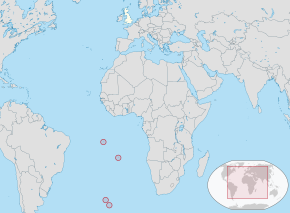


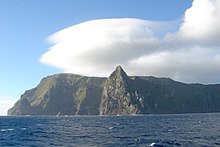
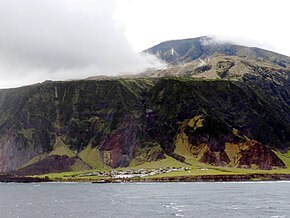
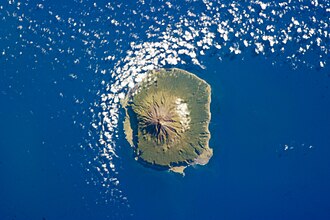


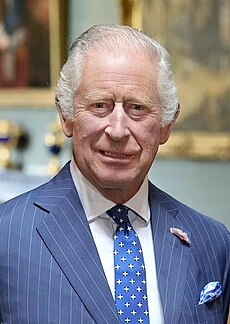
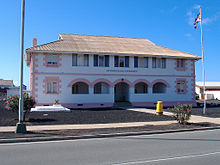
![St. Mary's Anglican Church [de], Ascension ASCENSION ISLAND - ST. MARY'S ANGLICAN CHURCH.jpg](http://upload.wikimedia.org/wikipedia/commons/thumb/1/14/ASCENSION_ISLAND_-_ST._MARY%27S_ANGLICAN_CHURCH.jpg/220px-ASCENSION_ISLAND_-_ST._MARY%27S_ANGLICAN_CHURCH.jpg)

